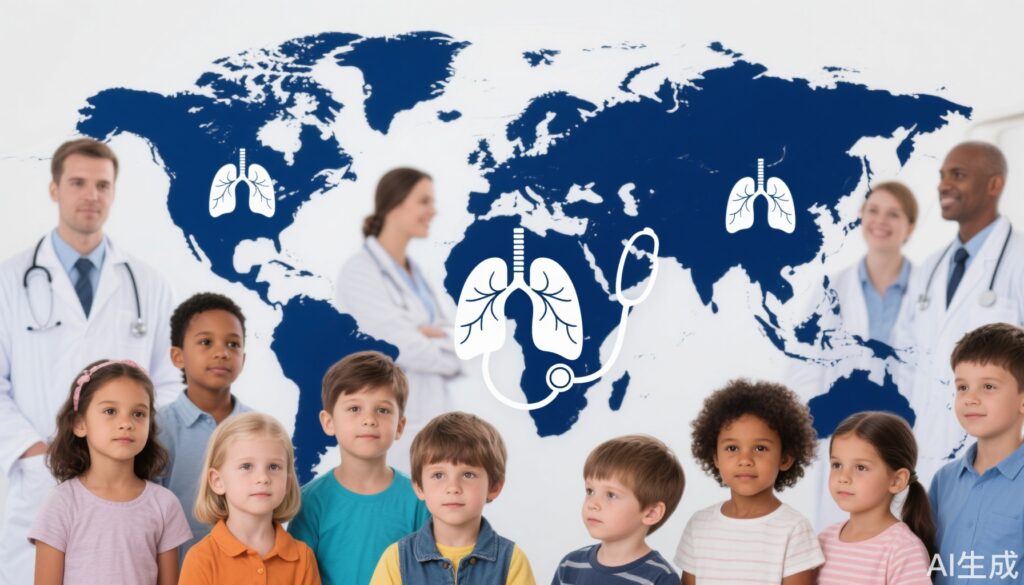Highlights
- First multinational paediatric bronchiectasis registry reveals substantial regional differences in disease etiology, lung function, microbiology, and therapy.
- Quality-of-care indicators fall short of international consensus, particularly regarding physiotherapy access and multidisciplinary management.
- High prevalence of severe exacerbations and hospitalizations in children, despite variation in treatment protocols.
- Findings emphasize the urgent need for harmonized, evidence-based care and resource allocation globally.
Study Background and Disease Burden
Bronchiectasis in children, once considered rare outside cystic fibrosis, is gaining recognition as a significant global health issue. Characterized by persistent bronchial dilation and chronic respiratory symptoms, paediatric bronchiectasis carries a substantial burden of morbidity, including frequent infections, impaired lung function, and repeated hospitalizations. Despite this, data on disease characteristics and management across different countries have been lacking. The Child-BEAR-Net Registry addresses this gap by providing the first multicountry, prospective data set to evaluate the clinical features, etiologies, and care quality for children and adolescents with bronchiectasis worldwide.
Study Design
This multicentre, cross-sectional cohort study enrolled children under 18 years with a clinical and radiological diagnosis of bronchiectasis (excluding cystic fibrosis and post-transplant cases) from secondary and tertiary hospitals in eight countries. Data collection spanned June 2020 to February 2024. Patients were categorized by four geographical regions: Australia, South Africa, Greece-Italy-Spain, and Albania-Türkiye-Ukraine. Baseline clinical characteristics, underlying causes, comorbidities, treatments, lung function, bacteriology, radiological features, and quality-of-care indicators (such as specialist access and recommended investigations) were analyzed using descriptive statistics and non-parametric comparisons between groups.
Key Findings
Patient Demographics and Disease Onset
The study included 408 children (56% male), with a median age at diagnosis of 6 years. This early age at diagnosis is consistent with the known natural history, where symptoms typically manifest in pre-school or early school-age children.
Etiology and Comorbidities
The most common underlying cause was post-infectious bronchiectasis (31%), followed by primary and secondary immunodeficiencies (19%) and known genetic disorders (13%). Notably, the prevalence of comorbid asthma (17%), otorhinolaryngeal disorders (14%), and congenital airway malformations (13%) highlights the complexity and multifactorial nature of the disease.
Clinical Course and Severity
Disease burden remained high: 38% had at least three exacerbations in the previous year, and nearly half (49%) required at least one hospital admission. Daily sputum production was reported by 27%, reflecting persistent airway inflammation and infection.
Lung Function
Lung function varied markedly by region. While 59% of tested children had normal forced vital capacity (FVC), the median FVC Z score ranged from near-normal in Australia (-0.12) to significantly reduced in South Africa (-1.54), indicating more severe impairment in resource-limited settings. These differences may reflect delayed diagnosis, access to care, or environmental factors.
Bacteriology
Regional variations were striking: Haemophilus influenzae was much more common in Australia (70%) than in Albania-Türkiye-Ukraine (16%). Pseudomonas aeruginosa, associated with worse outcomes, was most prevalent in South Africa (24%), but rare in other regions. These differences influence treatment choices and highlight the need for region-specific antimicrobial stewardship.
Treatment Variation
Long-term azithromycin use ranged from 50% in Greece-Italy-Spain to just 19% in Albania-Türkiye-Ukraine. Inhaled corticosteroid use was highest in Albania-Türkiye-Ukraine (61%) and lowest in Australia (22%), despite limited evidence for their routine use in bronchiectasis. This likely reflects local prescribing habits, resource availability, and possibly misdiagnosis of coexisting asthma.
Radiographically, cystic bronchiectasis (indicative of more advanced disease) was common in South Africa (45%) but rare in Australia (2%), suggesting differences in disease progression or access to early diagnosis and intervention.
Quality-of-Care Standards
While 66-95% of patients received the recommended diagnostic investigations, only 47% had seen a paediatric physiotherapist in the previous year—a key component of bronchiectasis management for airway clearance. Multidisciplinary access remains suboptimal, exposing a critical gap in care.
Expert Commentary
These findings expose a landscape of global inequity in paediatric bronchiectasis care. Regional variations in etiology, severity, and microbiology underline the importance of context-specific clinical pathways and the dangers of one-size-fits-all recommendations. The high rate of severe exacerbations and hospital admissions, even in resource-rich settings, suggests a persistent unmet need for early diagnosis, standardized management, and patient education.
The underutilization of physiotherapy, despite guideline recommendations, is particularly concerning. Multidisciplinary models, including specialist respiratory physicians, physiotherapists, and immunologists, are critical to improving outcomes. The observed variation in antibiotic and corticosteroid use also signals the need for better adherence to evidence-based protocols and ongoing clinical education.
The study’s cross-sectional nature and reliance on tertiary center data may limit generalizability to all settings. Nonetheless, the Child-BEAR-Net Registry sets a benchmark for future prospective and interventional studies and underscores the urgent need for harmonized care standards.
Conclusion
The Child-BEAR-Net Registry’s inaugural analysis provides invaluable insights into the diverse landscape of childhood bronchiectasis. It reveals substantial regional differences in causes, disease severity, microbiology, and management, as well as significant shortfalls in multidisciplinary care. These findings highlight the necessity for harmonized, evidence-based guidelines and improved resource allocation, particularly for physiotherapy and specialist services. The registry establishes a foundation for ongoing international collaboration, quality improvement, and research that will ultimately benefit children with bronchiectasis worldwide.
References
1. Garriga-Grimau L, Kantar A, Grimwood K, et al; Child-BEAR-Net collaborator group. First results from the international paediatric bronchiectasis registry (Child-BEAR-Net Registry) describing multicountry variations in childhood bronchiectasis and its management: a multicentre, cross-sectional study. Lancet Respir Med. 2025 Aug;13(8):698-708. doi: 10.1016/S2213-2600(25)00089-X.
2. Chang AB, Bush A, Grimwood K. Bronchiectasis in children: diagnosis and treatment. Lancet. 2018;392(10150):866-879.
3. Polverino E, Goeminne PC, McDonnell MJ, et al. European Respiratory Society guidelines for the management of adult bronchiectasis. Eur Respir J. 2017;50(3):1700629.
4. World Health Organization. Bronchiectasis: the global burden. WHO Fact Sheet, 2023.


